LSR 2-1 M-8 Softail
Bonneville, Dyno, & Track Proven Since
1978:
No Stupid Megaphones
, No Stepped Headers, No Aluminum Butt Plugs
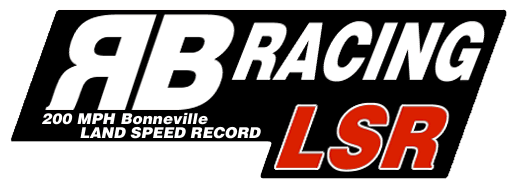
The Question Everyone
Asks: " What is the best 2-1 Harley M8 Softail Exhaust"
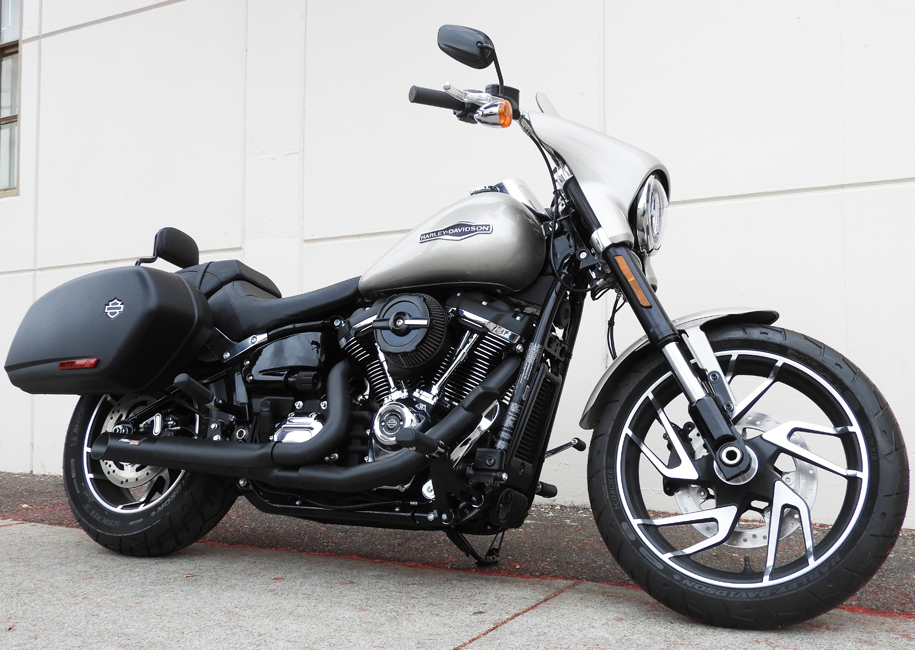
Purchasing the LSR 2-1Exhaust
1. Go to the Partnumbers Page to Locate your bike
2. Systems come complete with
a. Included in
price: Look Up Heat Shields to see what comes with your
exhaust: Heat
Shields
b. Included in
price: 00-1000 / 00-1001 / 00-1002 Flanges
/ Clips / Nuts
Three LSR 2-1 Finishes
1. Show Chrome:
The brightest chrome, the "Hexavalent" process, has
been outlawed in California since January 2024. Chemicals in
the Hexavalent process can be cancerous to
chrome shop operators, not the end consumer. The currently legal "Trivalent"
chroming process has a darker hue and does not
visually "pop".
Our chrome shop of
26 years finally shut down their Hexavalent plating
line in 2024 in spite of having a two year extension
to operate.
We are working with a new chrome plater,
in business for many decades, who still uses the
Hexavalent Show Chrome process and understands
motorcycle exhausts.
All LSR 2-1 Exhausts
and heat shields are mirror polished and plated with
Hexavalent Show Chrome.
2. Silver
Ceramic: Looks like polished aluminum, Can be
re-buffed with Mothers Magnesium & Aluminum
Polish. Will not "Blue" and will not come off or
rust. Holds in heat. Usually used with chrome or
silver heat shields. Fired twice @ 600F. Zero
problems in more than a decade. Not internally
coated and no internal media contamination as
exhausts are sealed during the process.
3. Dual Coat Black Ceramic: Silver Ceramic base with secondary coat of Black Ceramic. Fired three times @ 600F. Only black Finish that will hold up. Zero problems in more than a decade. Not internally coated and no internal media contamination as exhausts are sealed during the process.




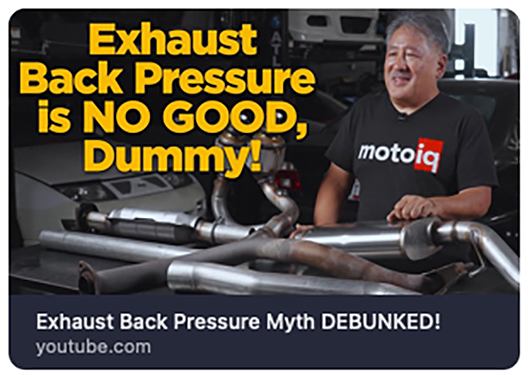

TTS MasterTune, a TTS Camshaft
and a RSR Dual Display AFR Gauge for, as you ride,
monitoring to perfect your tune. Full 2" primaries, billet
gaskets, and CNC machined turbo venturies.
We tried megaphones 30 years ago.
They are a waste of time. It's old tech for Norton Manxs and
pukka 1950's English bikes. There are no megaphones on any
race cars...formula, GP, rallye, NASCAR...Nowhere. 45
years of this shit. We've seen it all.
Welded
Non Removable Baffles
All LSR 2-1 designs have a welded-in,
non-removable, baffle. LSR Pro Stock 2-1 designs have
no baffle (optional welded-in baffle at time of order).

00-1416 Quiet Baffle is optional on our +5"
Slash Cut designs (Above).
There is no possibility of a baffle or end cap
coming loose because there are none. Zero maintenance for
life. No tone change over time,
For those of you who want to "tune" your exhausts...Not ours as they are already optimized. Consult your baffle advisor for appropriate anxiety medication.
M8
Softail 00-1419
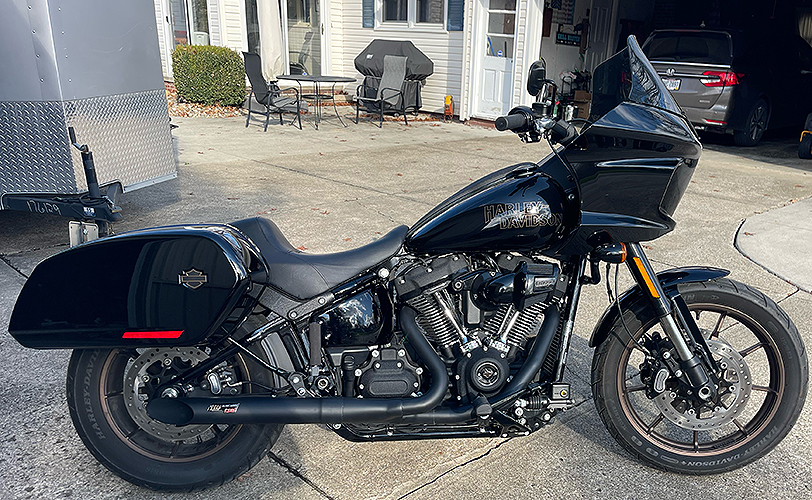
Customer writes: "Sorry about all the
trouble (*).I hope you are having a good week. Here's
my end results and I love it. Phillip".
(*)
Note: Exhaust was sold several years ago by a dealer
but the customer never installed it nor any other
items purchased. The next customer traded a Panhead
for the above bike and purchased the exhaust and
called us with questions. We searched our data base
and sent him at no charge an updated bracket assembly
that matched our latest installation instructions. No
we did not send the free bracket next day air. Get
real.
M8 Softail 00-1406
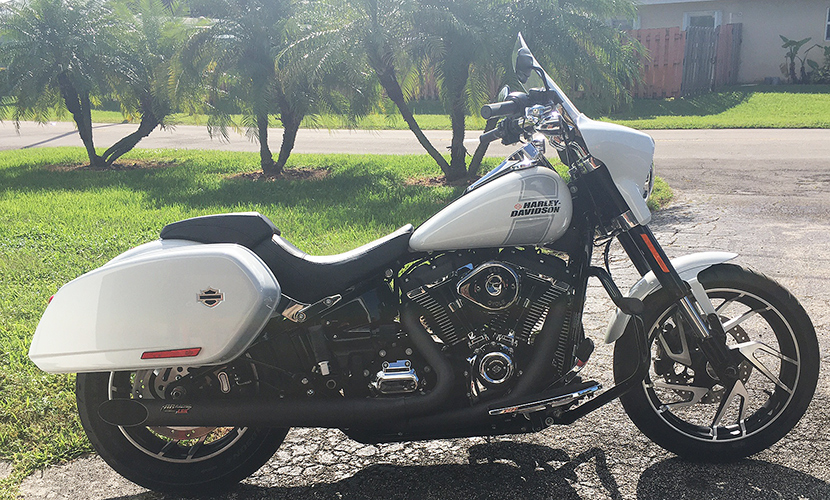
M8 Softail 00-1406
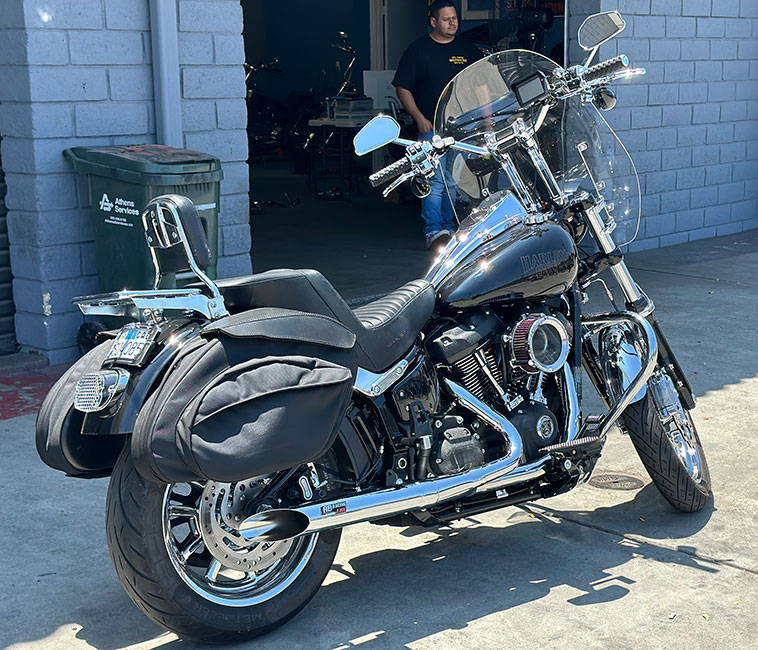
2022 FXLRST...
00-1419
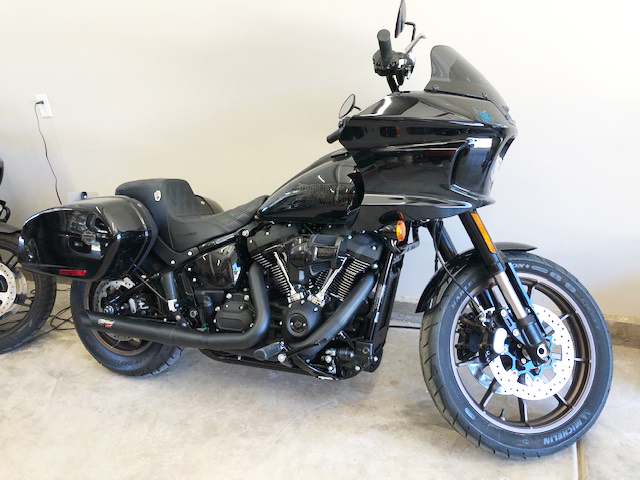
Customer writes: "Good
morning, I'm really surprised at how well this thing runs
with nothing other than your exhaust.The
modifications that I did to fit the pipe and the pipe itself
worked without fail. I'm having
second thoughts about installing the cam and S&S 128 kit
that was set aside for this bike.
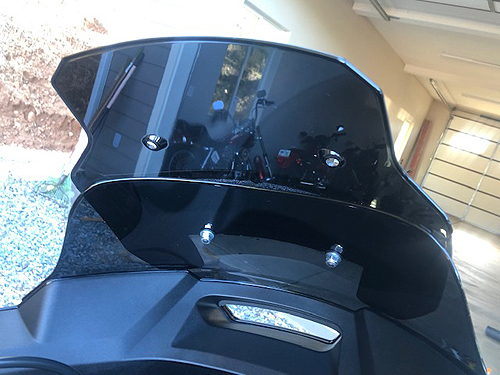
No one makes a decent windshield
for this model yet so I duct taped the short shield from
our Pan America up and down on the stock one until I found a
good location and drilled 2
holes and added velcro along the top to fasten it on the OEM
one.
We took off from Our place in Wyoming and rode
through,SD,ND,MN,WI and the UP of MI
before heading back down towards Green Bay and back to
Wyoming going close to 2500 miles.
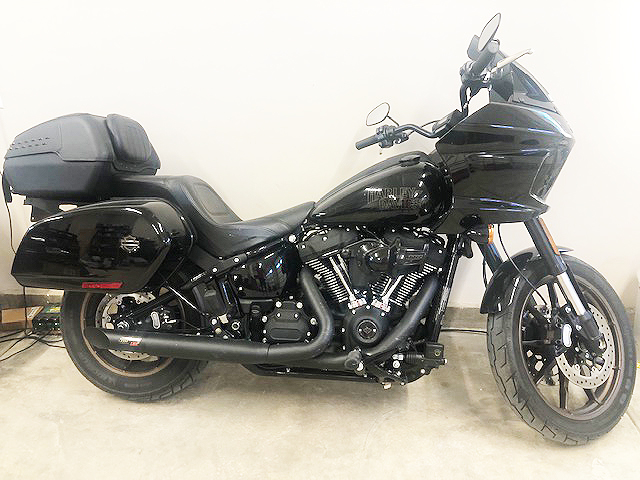
40-60 MPG depending on speed with power and torque
everywhere with Susan, myself the
trunk and saddlebags full..We rode much slower through
upper Wisconsin and along the
Mississippi River in Minnesota.Back in the plains I opened
it up quite a bit.
The initial break in was done by ND and We stopped in
Bismarck
for an early 1k service because NO other dealers along the
way could fit Us in.
Once again and for the 7th bike, your exhaust systems are
second to none.
We appreciate Your help,customer service and friendship.
Scott & Susan."
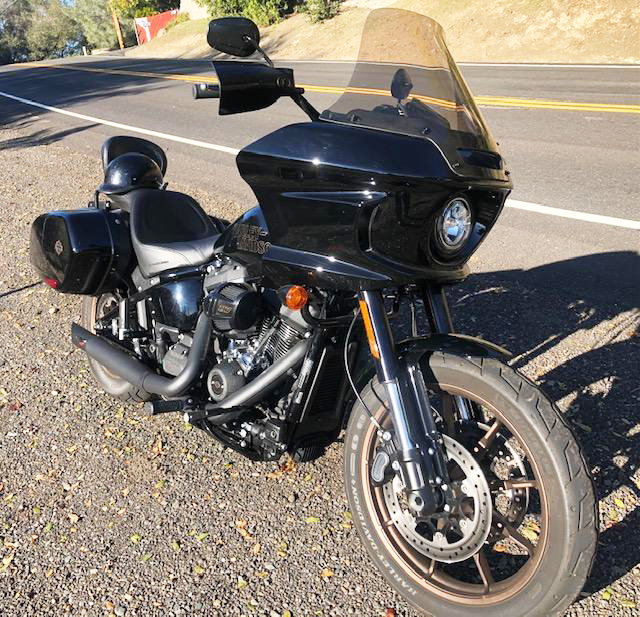
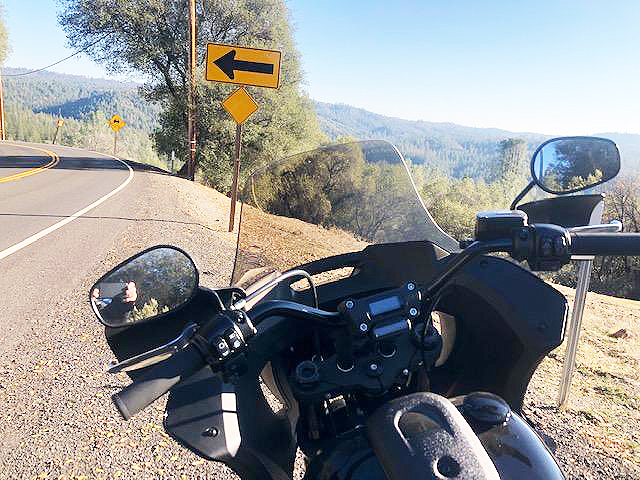
"I was lucky enough to get one of the
pre-production Clearview Windshields to test .....luckily
before all of the recent rain and snow.It works way better
than My custom creation and should be comfortable for all
future miles.We had a Clearview WS on Our FXRT fairing on
another bike that also worked well. We hope everything is
good a RB Racing. Scott"
Aftermarket Mid
Controls M8 Softail: "B" Style "2"
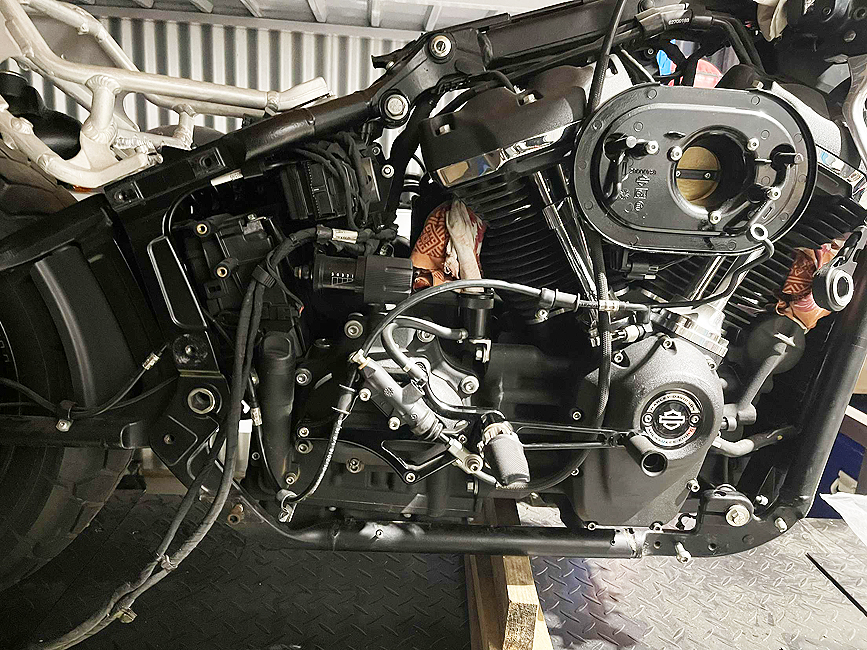

Customer installed
these mid-controls from Speed Merchant...Our "C" Style
exhausts run right through this foot peg location...So we
prototyped up a "B" exhaust...for Turn Outs, Slash Cuts,
Pro Stock, Pro Stock Spyder and Black Hole variations.
Here just
verifying bends and locations for testing.
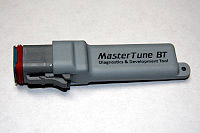
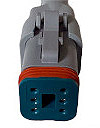
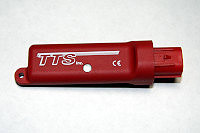
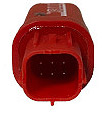
When you order the TTS
MasterTune, a LSR 2-1, and our RSR Air Fuel Ratio
gauge, and a TTS Camshaft (see below) there is a
$100.00 discount. Real world.
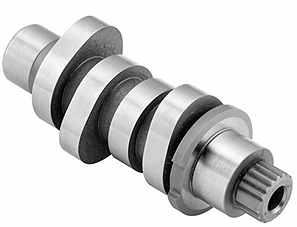
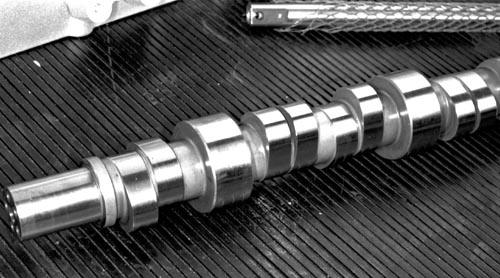
TTS M8 Camshaft left above.
Mercedes / Illmore pushrod V8 Indy winning 265E camshaft to
the right. Pay attention to the lobe design.
Ilmore found that with a pushrod design there was so much
monkey motion going on between the camshaft lobe and the
actual valve opening that it made more power and torque to
gently (preload if you will) open and close the valve.
Slamming the valve open introduced disastrous harmonics and
accelerated valvetrain wear.
Steve Cole designed his TTS 100/150/175/200 camshafts
plotting the acceleration rates contrary to what others did
i.e. banging the valve open and shut. Years later Steve
finds others are copying his designs even if they do not
know why he designed them that way. Camshaft
descriptions.
If you actually ride instead of parking and talking about
your dyno session you will find the TTS cams will outperform
all others in the vital roll-ons in the 1000 to 4000 RPM
range.
TTS M8 cams are priced at $275.00. $358.00 for Twin Cams. In
stock at RB Racing to pair up with our LSR exhausts and our
RSR Air Fuel Ratio meters.
2018 Heritage
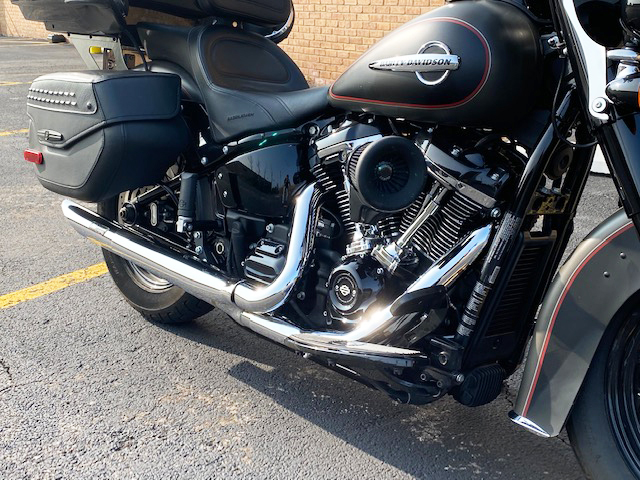
Customer writes: "Love the look, love the sound, worth the wait!!! Thanks again. -Keith K"
00-1405 with Slash
"Down".

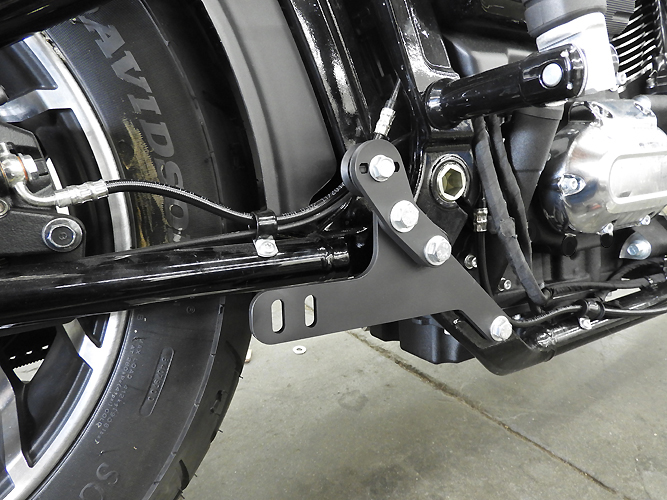
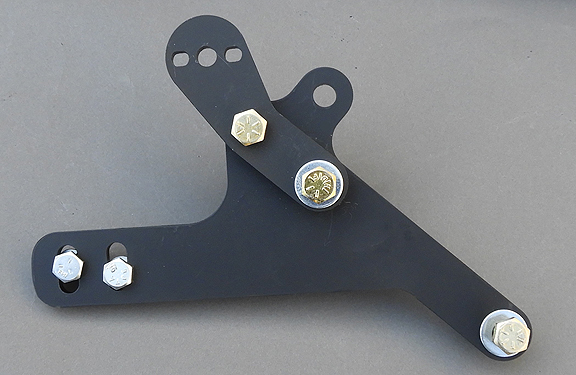
Milwaukee 8 Exhausts: 12mm and 18mm O2 Sensor Ports

When removing the stock M8 exhaust and installing the RB Racing LSR 2-1, the 12mm O2 sensors first have to be unplugged. Push the latch down as indicated by the red arrow. The sensor itself is a 14mm hex. Do not twist the sensor wires trying to leave the sensors attached to the bike.
Real World
Tuning Package

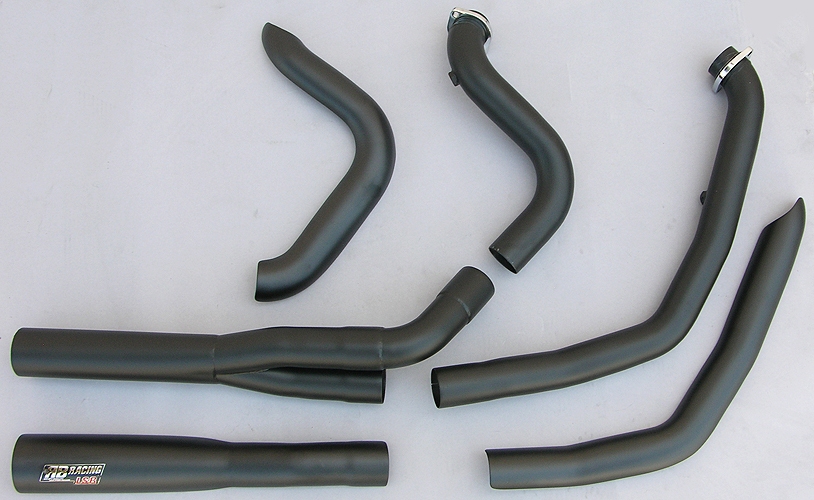
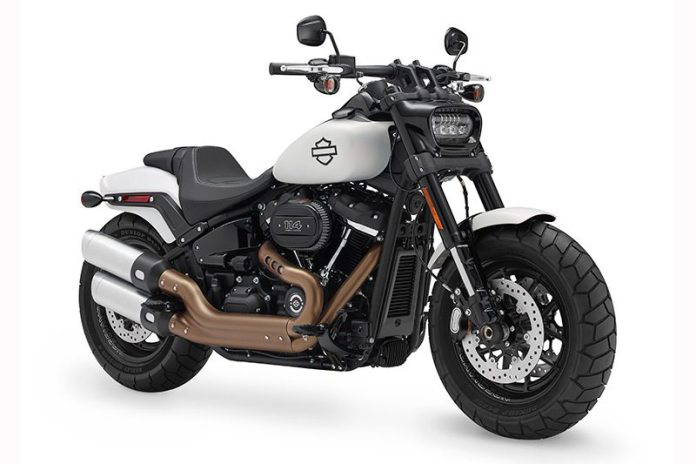
Military Discount
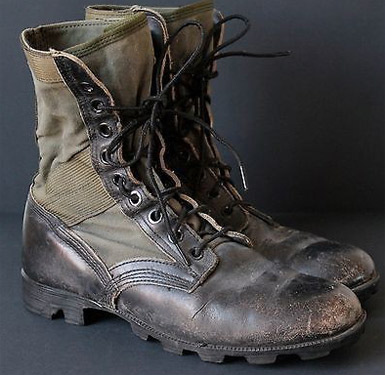
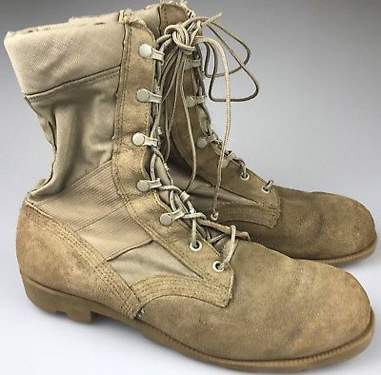
We offer a 10% discount to active or prior service both US Military and the Coast Guard on LSR 2-1 exhaust purchases.
Soot
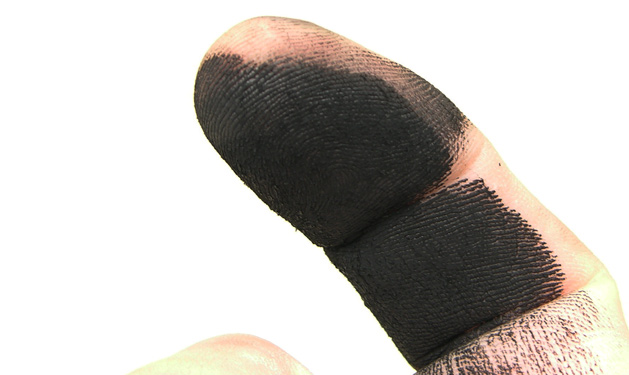
Whenever you look at an exhaust and see it caked in black soot you know the bike is not running or tuned correctly. Back in the mid 1980's we did a carburetor development program for Keihin Corporation for their 41mm CR Race carbs on both Shovelheads and the new Evolution motors. When we were finished the bikes got 56 mpg cruising and 46 mpg if you ran them harder...and after 500 mile tests the pipes were perfectly clean inside and the exhaust ports were dead clean.
If you take the
exhaust system off a modern Closed Loop BMW, as we have,
you will find them dead clean or whitish inside. Harleys
should be the same.
We always ask
what mileage people get from their "tuned" or modified
Harleys after "Dyno tuning"....The universal answer is
37 mpg or less. If they don't know, we ask them if they
have to gas at 100 miles. Most do.
Once a customer bought an exhaust from us and took his bike to two different dynos in search of the "117 Hp" he was looking for for his 103...He got 110Hp. After pissing and moaning we told the guy to give us our exhaust back and we found it caked in soot. So much for tuners and their tail pipe sniffers that see lean reversions...They just kept adding fuel. You tell the customer to put on our RSR Air Fuel Gauge to monitor the mixtures F/R in the real world...No, they want a "Dyno Tune". We have dynos...we know what they do and can't do.
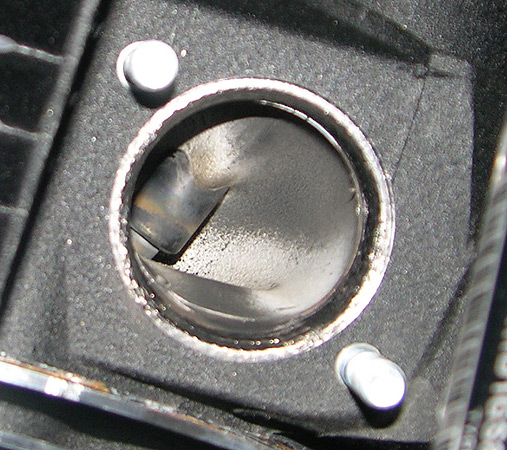
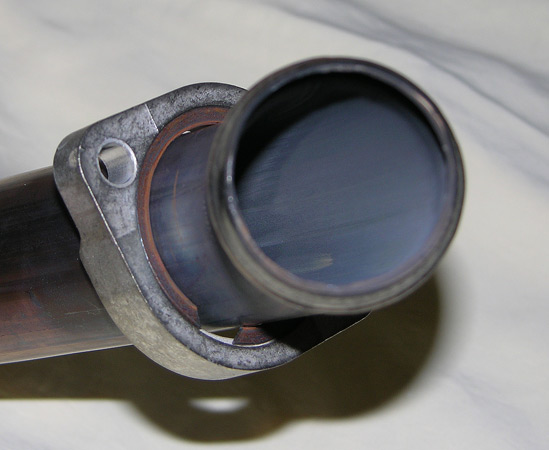
Pictured above is the exhaust port from a 2017 Dyna Low Rider S with about 100 miles on it. No soot. Delphi engineers seem to have done a very good job. Looks like the port you would see on a BMW. Now, when your "Tuner" gets finished with it, it will most likely be full of soot. Logic plays no part in people and their toys. EFI is complex...put in different cams, change air cleaners, port the heads and all this goes out the window. Brave new world.
No soot.
Fuel Injection..A Reality Check
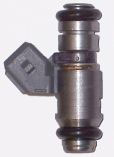
OEM
HarleyDelphi Injectors come in various ratings: 3.91
grams/second; 4.35 grams/second; 4.89 grams per second
(CVO); and 6.00 grams per second. These ratings are
static i.e. shorted open. Pulsed static is about 90%
of this i.e. what you could expect if you maxed them
out in your ecu calibration software. If you hold them
to an 85% duty cycle they, respectively, offer the
following horsepower potentials: 105 hp; 117 hp; 131
hp and 161 hp. Now, you can squeeze more out of them
by going past 85%, but this is the point where they
are still controllable.
We get calls
from people building wazoo big engines and they are
still running the stock injectors. We suggest you get
the right injectors for your engine building projects.
We offer a several calculators for those messing with
efi systems. Fuel
Injector Calculator Professional
Injector Pulsewidth Calculator.
236hp
Injectors
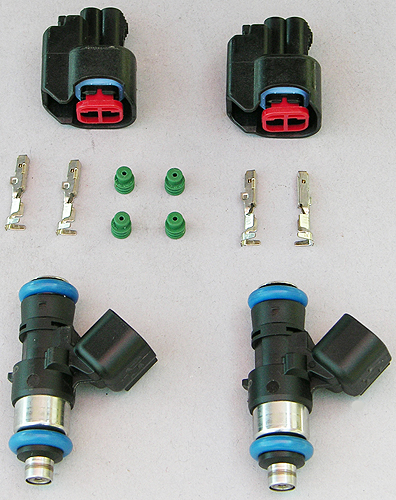
Bosch High Impedance Racing
Injectors rated at 236 hp at a duty cycle of 80%. 9.3
Grams/Second. Used in our Harley Turbo Kits and in big
inch motors. Direct insertion into stock fuel
rail/throttle body.
New Small M8 (12mm) and Older
(18mm) O2 Sensors
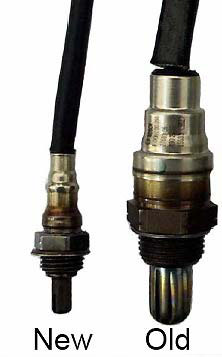
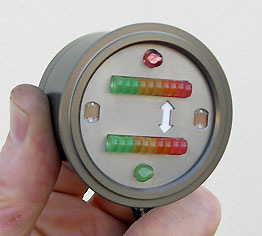
In 2009 FLT/H Twin Cam models
went to the new small heated O2 sensors. The Dynas and
Softails went to these in 2012 and the Sportsters in 2014.
All M8's for 2017 and up have the
12mm Delphi mini switching O2 sensors.
We are tooled for these smaller sensors on all the newer models. The small O2 Sensor models have a floating ground voltage offset that has a complex scheme that varies the signal to meet emissions purposes. If you think you are going to trick these you are in for a surprise.
You must specify the year of your motorcycle when ordering the RSR Dual O2 Gauge. Models with the small OEM O2 sensors will require two 18mm O2 ports in addition to the 12mm ones to monitor your bike as you ride. Our RSR Dual Gauges will monitor the 18mm high temperature O2 sensors we supply. It is the only method to monitor both front and rear cylinders of your bike as you ride. Real world observations to perfect your tune. Better than a dyno which tends to overheat your motor quickly skewing your tune.
M8 RSR Air Fuel
Ratio Gauges...Real World Tuning...Dyno on Your Bike
The Mother of all
gauges! Not a gauge, but a precision tool that will tell you
exactly what your engine is doing in real-time. Gives you
instantaneous read-outs of air/fuel ratios from 17:1 to
10.5:1 and indicates maximum power ratios. Four color
display is easily read in direct sunlight and automatically
dims at
night.
Waterproof, billet aluminum construction. Your significant other will cheat on you but this gauge will never lie! It won't keep you warm at night, but a perfectly running engine will look and sound the same when you wake up next to it the morning after.

Mounts....Roll Your Own or Buy One
The gauges have a center back mount 5/16" x 18 x 1/2" Stainless Socket Head Cap Screw and stainless lock washer. You can fab your own bracket for this or use the 06-1025 hard anodized Billet Mount System for either 1.00" or 1.25" handlebars $49.95. Optional is the 06-1024 two piece laser cut 304 Stainless Steel mounting tabs for either near handlebar clamp or up the handlebar mounting: $9.95.
Since we have been doing closed
loop fuel injection systems for Harleys for more
than 30 years and have been putting O-Sensor Ports in
our exhausts for even longer, we have both single and
dual O2 ports for our full range of exhausts. Our RSR Air
Fuel Ratio Gauge is the best
investment you can make for monitoring and optimizing
your engine tune.
All LSR 2-1
exhausts come standard with one or two O2 ports
(Sequential EFI models)...18mm or 12.5mm. O2 or Lambda
sensors are a necessity for either carbureted or non
closed loop efi (Weber Marelli and Early Delphi)
Harleys. We should know, as we have a lot of experience
with them and have been doing Closed Loop EFI systems
since 1989.
The gauge is
housed in a hard anodized round enclosure in a standard
2" format with a 2.250" bezel, center back mount, with a
5/16" x 18 stainless socket head cap screw. The gauge
will show fuel ratios from 17:1 to 12.0:1 (or richer).
The gauge is visible in daylight and automatically dims
for nighttime operation. Only a single L.E.D.
illuminates. A PDF on its operation
Very easy to interpret at a
glance. Scale is, left to right, lean to rich: three
greens, three yellows, two orange and two red l.e.d.s.
You simply cannot "read" spooling digital numbers.
The white arrow indicates the maximum power mixture, the second orange light, which is 13.2:1. Transitory enrichments should not, if the engine is warm (>200F Oil temp), go past the first red light. Readings at the far right side of the scale, the second red light, are simply too rich. Proper closed loop operation will cycle back and forth from green to orange around the center of the display.
It is simply the best way to evaluate the tune of your motorcycle and saves valuable dyno time. Mounted permanently. Waterproof.
Whether your
bike is carb or efi this is the best way to tune...By
riding and observing, not on a static dyno. Dynos are
not exactly real world in terms of loads, airflow, or
transitionals, and even if you had a million dollar AC
Transient dyno room, you would still have to do real
world testing. The gauges are dead accurate and are
millisecond fast responding which makes it very simple
to interpret or remember, even at a glance, while you
are dodging cars watching for cops. We have a Superflow
CycleDyn which gives a better real world
correlation than other dynamometers but we still
evaluate air fuel ratios when riding.
Anyone who tells
you optimizing tuning is easy is full of shit. Engineers
at Ford say they spend two years just perfecting tip-in
or initial throttle openings. Ride, observe,..then
change or edit. Real world.
Pretty soon Harleys will all be watercooled then you really won't be able to tell the difference between Milwaukee and Hammatsu. "The Man" will be sniffing your butt and planting microchips and gps modules up your ass so they can mail you a speeding ticket and keep track of your movements. They already have data recorders on your car so they know what you were doing when the biggie happened. Brave new world. Monitor your engine to get the most out of it before the NSA monitors your tail pipe.
LSR 2-1's Down Under
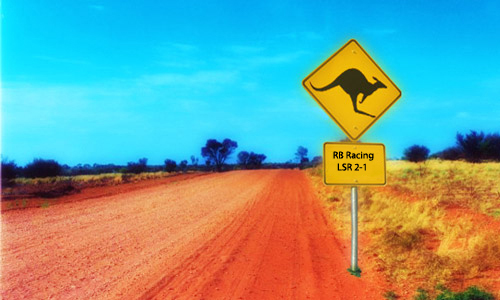
We ship LSR 2-1
exhausts direct to customers in Australia. Middlemen always
seem to want to sell things but not actually buy
things...and when they do, the price goes sky high and often
they order the wrong parts for the customer who has to wait
forever... Too many layers.
Customer writes: "I got the 00-1167 LSR 2-1 model C 45 rotation black pipes.I installed the
Do Not Use OEM Gaskets
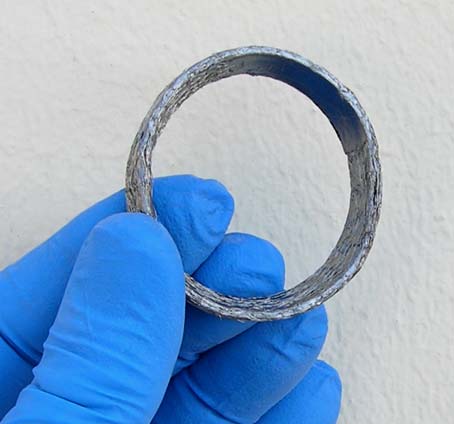
LSR 2-1 Exhaust Systems must use our CNC Machined Billet Gaskets (part number 00-1000) and our close tolerance aircraft exhaust nuts (part number 00-1001). The above OEM woven gasket will not work with our machined Turbo Venturis. Four special aircraft exhaust nuts come with the system but you must order four extra ones for $3.00 as they are easily dropped and the OEM 5/16" x 24 hex nuts will not "turn" on our machined Turbo Venturis.
We also offer machined from billet exhaust flanges. If you have a 2004 or later bike it will probably have the thicker exhaust flanges which are not compatible with our Turbo Venturis. Early style OEM Evo chrome die cast flanges and clips or our billet parts are called for. Our Chrome Billet Steel Flanges and clips are $29.95 per set and are stronger than any oem part.
We have had several instances where people encounter "difficulties". Invariably, it is traced to someone not using our billet gaskets. The billet gaskets insure proper fit of the LSR 2-1 system and are designed to work with our Turbo Venturis to increase exhaust flow.
Customers
Customer writes: "First, I have had your LSR 2-1 C w/Turnout on my 98 FLSTS for about 4 years and 32,000 miles. It looks great, sounds great, and of course, performs great.
Second, the mechanic that works on my bike also drag races a Shovelhead powered FL. He only ran Thunderheader until he rode my bike and did some research. Steve had you guys make him a 2-1 and set new records in his class.
Third, my brother-n-law has a '05 EFI Road King. He was just dying to put some Rinehart true duals on it. I talked him into waiting until he looked at and listened to a lot of RKs before buying. During the year he did this I kept asking what he wanted out of the new exhaust. Finally, he admitted sound and performance. He kept saying I love the sound of your bike and it is fast as hell. So, I suggested the LSR 2-1 C Slash Cut longer pipe. We installed your exhaust, a PCIII usb, and a K&N filter with stock a/c cover and changed the backing plate. His road king has torque and runs like a scalded dog. We both can out run 95" kits installed at the HD dealers.
I provided the background to say this. My B'law took his RK to the HD dealer for the 15k maintenance service. The mechanics went nuts over the exhaust and what it does for the performance. They asked all kinds of questions. They had never heard of your firm or the exhausts. Now comes the kicker and it makes me a little sad (because I have enjoyed having an exhaust that out performs the crap the HD dealers sell). The mechanics conclusion. They are going to take off that HD exhaust crap (their words) and get RB Racing exhausts. Now the word will spread around Memphis and RB Racing exhausts will be everywhere.
It was good while it lasted - having the performance edge over others.
Your exhaust system has been great on my bike for 4 years and 32k miles. Thanks for a great product. I can't imagine having any other brand of exhaust!
PS. Sure wish you would make a LSR 2-1 for Victory Jackpot or 8 ball. The only reason I haven't purchased one in the last two years is because you said you would NOT make a Victory exhaust.
Later Cliff"
Billet Flanges for 2005 and later Models
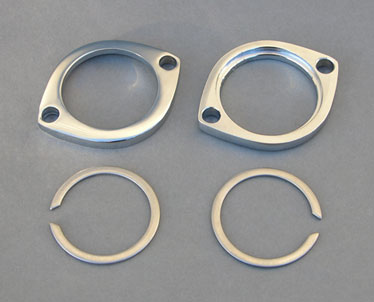
The Harley part numbers for these flanges and clips are: 65328-83 (exhaust ring clamp) and 65325-83A (retaining ring). RB Racing has these cnc machined flanges in stock, per pair with spring clips Part Number 00-1002, $37.95. 2005 and later models need to order these flanges or their equivalent at your Harley shop as the oem flanges may be too thick for our Turbo Venturis.
A pipe has to look as good as it works and every angle has been considered with the LSR 2-1. The pipe is designed to follow the motor's lines and to provide the necessary ground clearance while still allowing access to oil fillers, ignitions, and push rods. The 3" diameter tail section is available in Turn Out or Slash Cut styles.

LSR 2-1's Bonneville,Dyno &Track Proven
If you want to make power on a multi-cylinder engine you have to use a collector system. Whether it's a V-Twin or a V-8 it's the same, and no less an authority than the famed engine builder Smokey Yunick will tell you that. Not using free exhaust energy to help your engine breathe is downright criminal. No matter what the conventional wisdom is, staggered duals on a Harley will not make more power. You simply cannot escape the fact that a properly designed 2-1 will give you more usable torque where you need it, in the 2000 to 4000 rpm range, which means less downshifts and less rpm to get the job done.
A set of short staggered duals at peak rpm can be made to produce good power but they will be dead on their ass until they get there, whereas an engine developed around an LSR 2-1 exhaust can be made to perform from the bottom up with no dips in the torque band! If you don't believe this then why is it always that the top Pro Stock bikes, cars etc. end up running collectors systems? Damn right they work! If you don't think torque between shifts or when you roll the throttle on, then buy those long sewer pipes or some short curly drag pipes you saw on the Discovery Channel.
Check out our new Exhaust Technology Section for information on how all this works.
Typical Comments
Customer writes:
"Though it took awhile to get it, it was worth the
wait... Hi to you all at RB Racing this is Tony D.
I got my 02 Deuce back from my tuner today ( had
him map it ) it has the 95" kit 10.25 pistons SE
HP Heads and SE 251 Cams with a Power Commander on
it. It Dyno'ed at 87hp with the Vance & Hines
Short Shots I had on it. With your "C" Pipe (1167)
it now Dynos at a 103hp WHOW !!!!!!! or should I
say Holy Fuck-N Shit !!!!!!! What a difference the
RIGHT PIPE makes !
Though I haven't put very many miles on it yet the 45 mile ride home was a blast to say the least. A BIG THANK YOU to all of you at RB Racing.You had asked me to send a photo I do not have a digital camera so I will have to send a photo by mail please email me the address to send it to. Again THANK YOU !!!"
Self-Tuning Myth
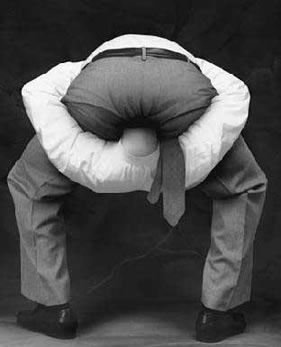
People have the idea that closed-loop systems are completely self-tuning and that they are going to sell you some add-on gizmo that will automatically tune your efi bike. This is a crock of shit. The truth is that every engine is different and, in the Harley world, difference is the norm as there are limitless engine build combinations.
In Detroit, Japan, or Germany, they spend thousands of man-hours developing base maps for their automotive applications. On top of these base maps goes the closed-loop feedback mechanism controlled by mathematical equations or algorithms that govern exactly how the closed loop operation will function. These base maps are not writtenso the vehicle will run perfectly without feedback i.e. maps are not designed for open-loop operation. The strategy for closed-loop operation is different as fuel requirements under different climatic and altitude differences can be as much as 30%. Unless the base map is constructed for the particular application, the O2 feedback mechanism will not work properly.
OEM correction schemes allow only very slight learning corrections or they will "throw" an error code. They do this for a very specific reason i.e. if things are going wrong, which is indicated by the system trying to correct out of bounds problems, then a sensor or something else is wrong. They are not designed to make large swings to correct calibrations that are way out of bounds.
14.7 / 13.2 = 1.11
People take their perfectly good Delphi electronics and swap them for a self-tuning "Wide-Band" system. The "Wide Band" manufacturers tell you to run their systems at an air/fuel target of 13.2:1. This simply puts 11% more fuel through the engine, i.e. if you were getting 40 mpg @ 14.7:1, you are now going to get 35.6 mpg. You might as well go get a carburetor.
The objective of closed loop and narrow band sensors is to get the most efficiency out of your engine by targeting 14.7:1 except in warm-up, sudden transitions, and wide open throttle, as well as hard deceleration and or fuel cut-off. Ratios as lean as 17.0:1 can be run under deceleration and certain no load situations.
FYI maximum constant torque occurs around 13.2:1, whereas sudden transitions can be anywhere from 12.5:1 to 10.0:1 depending on temperature conditions. It isn't simple. EFI isn't Linkerts, Bendix or S&S simplicity. The closest carb you can get to efi fuel control is a CV Carburetor.
Wideband
O2 Adaptations
Systems that typically use Bosch LSU 4.2/4.9 wideband sensors for self-tuning have a built-in problem. First, the "map" has to be correct before any of this self-tuning takes place. Secondly, the real issue is the sensor response time, i.e. the time it takes the sensor to stabilize, and for the ecu to make a corrected output. No matter what they tell your there is a significant delay between the reading and the correction, during which time the engine will be at another rpm/load site . This can be on the order of 980 Ms for the Bosch sensors which is why, in dyno testing, they use step tests for a number of seconds, letting the engine stabilize at specific load/rpm points, before any measurements or changes can be done. Constantly rewriting RAM locations with "corrections" on the fly is never going to be correct.
The OEM narrowband
Delphi system actually works twice as fast
500 Ms and the map, as delivered by Harley, is
correct. The Delphi ecm has the ability to adjust
about 20% in small increments (block learn
multipliers) to factor for air cleaners slowly
getting dirty etc. It already is self-tuning
except at wide open throttle.
Beyond Stupid
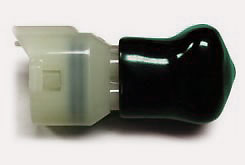
Some add-on boxes for late model O2 sensor equipped oem Harleys eliminate the O2 sensors altogether. Why in the hell would you want to take a self-adjusting, sophisticated system and turn it into a gas guzzling low mileage dumb efi system? Beats the hell out of us and, since we make closed loop efi systems, we do have some experience in this area.
You bike should be left in closed loop, tuned in closed loop and monitored with O2 displays in closed loop. Correction factors defined in the oem code cannot be exceeded. Maps have to be rewritten for the changes to the bike so the base map is in agreement with the oem algorithms.
Phone Sex and Remote Tuning

In some sort of logical disconnect a few customers call us up wanting us to tune their bike over the phone and then become increasingly indignant when we tell them it just doesn't work that way. Now, we spent the better part of 14 years, starting in 1976 working on carburetors, jetting, needle design, and even designed and marketed a flat slide carb for the Harley market. Thousands of man hours representing about 5 months out of every year were devoted to jetting issues. It got to be a real issue i.e. it was an interesting experience to define what the correct air fuel ratios should be, experimentally figure out how to measure them, and then deal with tuning die cast critters, often modifying them with extra circuits etc. but, in the end, it was temporal and an endless loop that did not exactly pay the bills.
We did learn how to make things run well, not that anyone appreciated it. It was fun to watch people try to beat you when they couldn't. Knowledge. Hard work.
For the last 18 years we've been working on and manufacturing closed loop fuel injections systems for Harley Davidsons and have set numerous Bonneville, El Mirage and Maxton speed records and won drag racing championships with them. We spent over 3000 man hours writing and perfecting Autocal.V6 prediction and analysis software for our RSR Fuel Injection systems. Why did we spend 3000 man hours? Well, we didn't plan on it, and it's a good way to flirt with insanity, but we saw no other option as digital efi requires hundreds of decisions, all of which are intertwined. No more brass jets. Exponential combinations. Changing points, one at a time is sheer insanity. Progress comes with increased complexity.
These days all Harleys are closed loop fuel injected with a single throat throttle body and are speed density Delphi systems, all very complex. It's the same formula we decided on 18 years ago. The only thing we suggest is that you use O2 signals to monitor and tune the system as the sensors are millisecond accurate and must be monitored at the exhaust port where temperatures are high and as far away from the outside oxygen rich air as possible. We suggest you use software, not hardware, to adjust your system using our RSR Air Fuel Ratio Gauges and keep your bike off of the dyno until the lights in these displays tell you your mixture is correct. Engines operate in a very narrow realm of air fuel ratios. If you want to go to the dyno after this...fine.
Just don't call us breathlessly demanding we tune your bike over the phone.
SuperFlow CycleDyn...Testing a Running
Motorcycle
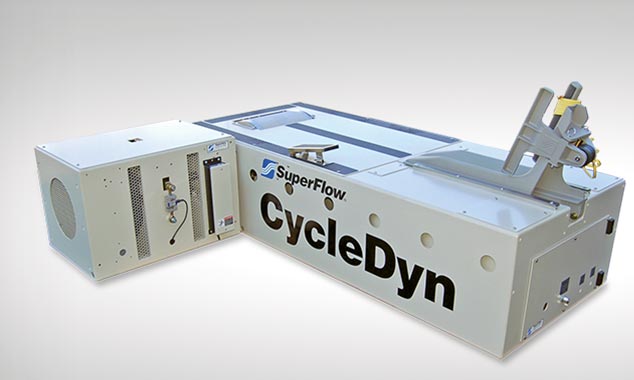
If you are going to use a chassis dyno it has to be a tool and not a toy. At RB Racing we use the SuperFlow CycleDyn as it best emulates the real world. We use it for development and not for publishing "dyno charts". Most of our work is with Pectel SQ6M controllers which have extensive internal datalogging and playback capabilities up to 2000Hz sampling rates. With the SuperFlow we can program specific tests and transient sweeps with our turbocharger systems up 750 hp in inertial mode or 500 hp in Eddy Current controlled accelerations.
For those
of you who like Dynojet "Dyno Graphs"..read
this article.
Steve Cole (TTS MasterTune) who has spent untold thousands of hours on every dyno imaginable has this to say about CycleDyns:
Steve
Cole: "In the development side what I can say is
the SuperFlow when setup properly emulates the
real world much better. As an example the only way
to get a DynoJet to give you HP and TQ is a WOT
unloaded run. The SuperFlow allows that plus just
about any other combination you like with real
torque output. So what does any of it buy you
becomes the question. I can tell you that if we
tune to a DJ and get the best we can, then repeat
on the SuperFlow using real world acceleration
rates for the engine being tested the results are
very different. Take the final calibrations and
run them in both dyno's unloaded and the DJ
developed type calibration will show the most HP
and TQ in those conditions, on both the SuperFlow
in DJ mode and the DJ. Then take the SuperFlow
controlled condition calibration and load it in
the bike the power will go up when tested in the
SuperFlow mode again which can only be done on the
SuperFlow.
Now the hooker, take the bike and put one of the
finished calibrations in it and give it to the
customer and say go ride it and come back after
you've ridden it well, to know how it feels/runs.
They come back after an hour or so then load the
other calibration and ask them to do the same
riding over and come back again. Each and every
time we have done this every customer has picked
the calibration that was done on the SuperFlow
under the controlled acceleration modes! So pick
what works for you but there is a difference. Does
it take longer, does it end with a measurable
difference............. YEP!"
When we
have turbo bikes like our Road
Glide Turbo it
gets a bit interesting to go testing in LA traffic
with police, cell phone cameras, and freeway
cameras. We still do real world riding with data
acquisition as the real world is where you ride.
People want "Dyno Sheets"...see below. We aren't going to test every damn camshaft, compression ratio, piston configuration, cylinder head etc as there is not enough money nor time to do so. However, we do testing for our own race development, R&D, and our personal development platforms.
Dyno Sheets

People
call us all the time asking for "Dyno Sheets" and
we patiently tell them we do not provide
self-serving graphs predicting fantastic
horsepower and torque gains. Plenty of customers
send us dyno sheets but, as we've been at this a
long time, we know the tuning game is too
complicated to provide numbers just to sell an
exhaust. Tuning is a multi-variable process.
When the
EVO motors came out Jerry Branch published his
famous manifesto on tuning 80" EVO motors...In
short, unless you bumped the compression the
horsepower was not forthcoming. Same these days.
In 2014 John O'Keefe of Branch
O'Keefe ran
an extensive series of tests on OEM Twin Cam
cylinder heads to see if he could offer a "less
expensive" ported head as everyone with a grinder
in his garage was suddenly an expert at cylinder
head porting. John found out that any attempt to
clean up the ports killed the flow and port
velocities dropped. He scrapped that idea and kept
his well-proven chamber modification, porting and
valve replacement system.
If you are looking for warm cuddly sheets we are clean out of them. We are tuners and you can buy all the trick parts in the world and a guy with a well tuned mild bike with a good power to weight ratio will kick your ass. Real world. Find a good tuner or become one. Look in the mirror.
Crystal Balls and Astrology

You win some, you lose some. Mostly we win. Like we always say it always depends on the tuner. This is not a parts changing business and we all know it's easiest to just change pipes and see what happens, but that's not science. The LSR 2-1 pipes, themselves, do not represent a "limit" as long as you choose the right pipe for your application. The rest of the equation is getting the parts and tuning to work together.
Just put the damn thing on the road, open her up, and see what she'll do. Let the metal scream.
Torque and Ruby Slippers
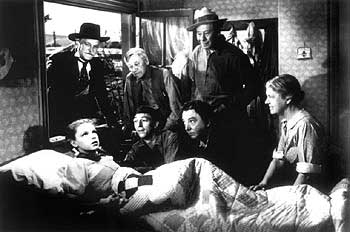
People get pissed at us when they ask for "numbers". We always tell them we "don't know" because after nearly 33 years of tuning and racing and designing we have seen too much and done too much to give any placebo answer. In fact it always depends on the bike and the tuner. No two bikes are alike. Maybe your bike was built on a Monday and they left a coke bottle in the gas tank (old Detroit wives's tale)...Some bikes are faster than others. Everyone believes their bike is "faster". It depends on the tuner and, these days, the bikes are more complicated. People change from chain to gear drives. They put on different cylinder heads. They switch cams. They add on tuning twiddle boxes. They tune, or the "shop" tunes. They "dyno" the bike...maybe even somebody rides the bike with instrumentation like our RSR Air Fuel Ratio Gauge.
People call us up then hang up when we tell them we don't know what their "gains" will be. We don't publish self-serving charts. We just take all the experience we have and build the best parts we can. People end up happy who buy the parts because they are well made and are designed to perform. We make different tube diameters and offer a wide range of systems for any particular bike so you will maximize your potential. There is no "One Size Fits All" at RB Racing.
People who don't buy the parts because we won't coddle them with assurances go elsewhere where Aunt Em will tuck them in and tell them what they want to hear.
New Cloisonne Tags
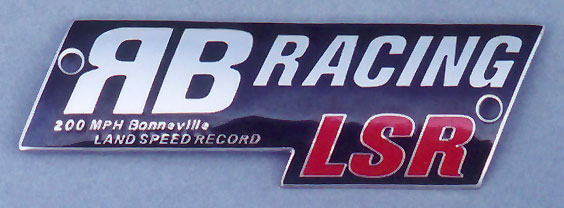
Like in the adage "The relentless search for perfection" we have upgraded the logos we put on our LSR Exhaust Systems. Previous tags were stamped and formed aluminum with silk screened details. The new cloisonne tags are a precision die struck brass, nickel plated, with powdered glass fired in an oven then polished to a jewelry finish. These are direct replacements for our older tags and are available for US $25.00 postpaid via US Global Express (foreign) or Priority Mail (domestic US). They come with black headed rivets and are riveted in place with a light coat of high temperature silicone (Permatex 598B) behind the tag.
Baffling Alien Discs and Aluminum
Butt Plugs 
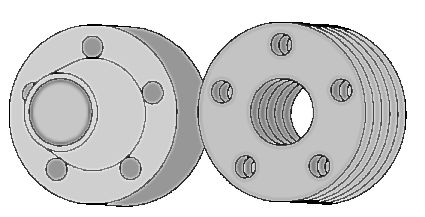
Our testing has shown
that the Harley V-Twin is extremely sensitive to
back pressure which is why 2-1's that use small
or restrictive collectors don't breathe well,
and whyrestrictive baffles shut
the motor down. Disc type baffles are good for
spark arrestors on dirt bikes but they have no
place on a big inch V-Twin. You don't make power
by adding restrictions to your exhaust system
whether it's a bunch of stainless discs or some
damn piece of aluminum billet machined into a
Harley butt plug!
Ever wonder why they
had to put a hole up the center of the discs?
Well, one reason was the discs are so damn
restrictive you have to have several pounds of
them to get enough flow through their waffle
shaped passages. Good mufflers, but they have
nothing to do with performance and they sure as
hell do not create vacuum as has been claimed.
When you get confused by all the bullshit simply ask the following question.." Do they run them in NASCAR or in Formula One?". Nope, they run straight pipe collector systems without any stupid discs or aluminum butt plugs.It's always funny how when the money is on the line, all the little things like discs, billet caps, anti-reversion flaps, reverse megaphones and other such nonsense somehow don't make the field.
All RB Racing LSR Exhaust Systems feature our "new" (we've been quietly doing it since 1985!) CNC machined Turbo Venturis that actually "scavenge" to help your motor breathe. Machined from billet, these allow full 2" flow and eliminate the phony restrictions that other 1 3/4" to 2 1/4" pipes have at your exhaust port. We supply special close tolerance aircraft nuts for your exhaust studs because our machined venturis are too wide for a standard hex nut.
Our CNC machined Turbo Venturis are not compatible with the "bowl-shaped" late model OEM exhaust port gaskets or early style "flat" gaskets for the LSR Exhaust Systems to both fit and seal properly. The narrow machined flat face of the Turbo Venturi must seat against a flat surface, not the bowl-shaped late model gaskets. Using the LSR Exhausts in combination with the wrong gasket will cause misalignment, inability to tighten the provided close tolerance aircraft nuts, and will force the bowl-shaped gasket into the exhaust port.
Mandatory for a
nominal charge of $9.95 are
a pair of our LSR CNC machined gaskets which
mate perfectly with our Turbo Venturis. These
are proven in over 16 years of use on our race
and turbo applications...the only gaskets that
will stay in a turbo bike for 25,000 miles!
These gaskets prevent any gasket "creep" into
the exhaust flow and are one more thing that
will give you "an edge" on the competition. We
always wondered why people would port their
heads, put in bigger valves and then squish the
gaskets into their exhaust ports.
We bet you never paid attention to what was going inside your exhaust ports for one very simple reason...you can't see what's going on in there once the pipe is tightened! The LSR CNC machined gaskets also insure perfect alignment of the exhaust system. Most fitment and alignment problems are traced to using either the wrong type of gasket or using old gaskets that have taken a "set". We've always used these on our race applications and it's time everyone who's concerned about performance should do the same.
All LSR 2 into 1 exhausts require special close tolerance aircraft nuts to bolt the LSR Turbo Venturis to the exhaust port. Standard 5/16" x 24 hex nuts will not fit. Each exhaust comes with the required four nuts. It is recommended that you order an extra set (4) of these nuts, part number 00-1001, when you order your exhaust.
Goo

RB Racing LSR 2-1 exhaust systems use either one or two slip joints depending on the model. We suggest you put a coating of Permatex 598B ULTRA BLACK in the slip joint. None of our slip joints use any clamps because then they wouldn't be slip joints anymore. The inner pipe gets hotter that the outer pipe and they grow into each other and form a tight seal. The 598B is a non hardening gasket material and will prevent any leakage from condensation that forms in the pipe and, with the usual carbon particles, will actually seal better over time. It also makes the pipes easy to take apart later on. Get a tube before you install your RB racing exhaust system.
As they say. So simple a.....
We offer general LSR 2-1 Mounting Instructions in a PDF Format.
Mounting Torques
For flanges and mounts we recommend 15 foot pounds of torque. On exhaust flanges you do not use any locking compound as our nuts are self-clinching. On bolts for frame and engine-mounted brackets we recommend that the threads be clean and that a low grade (Blue) thread locking compound be used with 15 foot pounds of torque. Bolts and nuts on our slotted brackets do not require a locking compound but can also be tightened to 15 foot pounds.
In lieu of torque wrenches do not over tighten exhaust flanges to the point where they bend. In the case of bolts going into transmissions and into frames also do not attempt to see how strong you are as aluminum threads and bolts are weaker than you and your wrench are. Simply tighten things till the bolt stops and give another partial turn to firmly snug it. The last bit of tightening actually stretches things a bit and the tension holds things tight. Tightening should always be done in a sequence. Never finally tighten one part then go to the next...Always loosely tighten things in sequence and then finally tighten things in sequence.
The exhaust should never be installed with any of its elements in tension. It has to rest in place without strain and be tightened without strain.
We employ split lock washers on most fasteners to prevent counter-rotation. This works surprisingly well if the bolt is properly torqued or tightened.
In any case, you have a responsibility to tighten things or at least check periodically as part of your normal maintenance. Harleys do shake and try to kill anything attached to, or even near them. If things get loose the additional shaking moment can break bolts and destroy threads.
General LSR 2-1 Installation Sequence
1. Remove the OEM exhaust and exhaust bracketry. If the bike has floorboards remove the right floorboard.
2. Pry the OEM exhaust gaskets out of the exhaust ports. We use billet gaskets instead.
3. Install the frame or transmission bracket provided. Use Blue Loctite on the mounting bolt threads into the transmission. Lockwashers under the bolt heads on the transmission mount. If through-bolt like on early rigid Sportsters or Shovels use lockwashers under the hex nuts.
4.
Front and Rear primary tubes: Install
billet flanges and clips. Install front
pipe loosely with billet gasket and nuts
provided. Loosely affix the front heat
shield to the pipe as you might not be
able to install the shield later with the
rear pipe in place. We use 1/4 drive
ratchet plus extensions and 3/8" socket
and a 3/8" wobble for the exhaust stud
nuts.
5.
If the rear pipe has a slip joint (rubber
mounted C Style) slip the rear pipe into
the tail section. You may use Permatex
ULTRA BLACK.
6. Begin slip of tail section/rear pipe into the front exhaust slip joint (You may use Permatex ULTRA BLACK) and work the rear exhaust and billet gasket into the exhaust port. Loosely affix exhaust stud nuts provided. We use 1/4 drive ratchet plus extensions and 3/8" socket.
7. Slide 5/16" x 18 bolt(s) into slotted bracket on back of exhaust and thread these through the mounting braket. Loosely affix with lock washer(s) and hex nuts provided. Some exhausts may require a spacer (provided) between the exhast slotted bracket and frame/transmission bracket.
8. Gently tighted up all fasteners and nuts. Nothing can be in tension. You may use a rubber mallet to seat the slip joint(s).
9.
Install remaining heat shields and tighten
front heat shield (5/16" Nut driver).
Completely wipe the pipe and shields down
with a clean cloth to prevent grease and
oil stains from being baked on.
10.
Run bike briefly in place. Let it cool
down and retighten fasteners. Reinstall
the right floorboard with hardware
provided.
11. If ceramic finishes it is wise to go through several heat cycles. On modern efi closed loop systems they go into closed loop within minutes. Let bike idle for a few minutes then shut it down to let it cool. Several sessions of this will cure the resins as they are only oven-fired to 400F. Exhaust temperatures are >1000F.
12.
Double check all fasteners and ride the
bike. Check your work afterwards. You
bought a Harley so you are already showing
signs of dementia.
Newer Dual Coat Black Ceramic Finishes
We have a lot more people looking for durable ceramic finishes and we think we have the best finishes on the market. In the late 70's and early 80's we tried all sorts of coatings and paints and even used porcelain on some of our products in the late 1980's. The newer ceramic finishes are tougher and we use both Polished Silver, and Semi-Gloss Black, to complement our usual chrome offerings. The newest "Turbo" Black finishes are a dual coat process that gives additional protection against scratches and nicks, providing two barriers against corrosion.
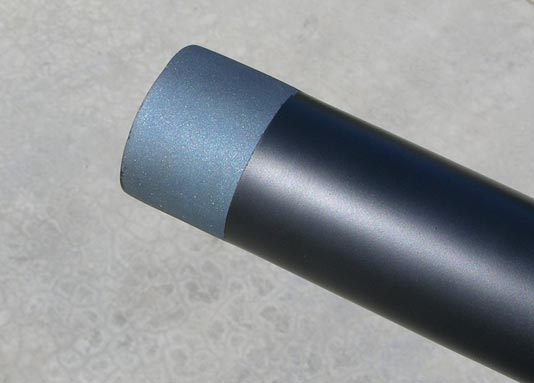
In more than 3 decades we have tried all sorts of black finishes: Kal Gard, VHT, Techline, and others. We also in the mid 1980's we even tried porcelain for awhile. It chipped and the heat distorted the parts. Most finishes will not survive over a long period unless they have a base coat to cushion rock strikes and scratches. The surface has to be perfectly prepared and most applications can fail if run too soon at elevated temperatures as they are typically baked at 450 to 500 deg F whereas the cure takes place at around 750 deg F. Lower temperatures will not cure the resins and they will fail once the bike is run. To get around this dilemma we have found the best solution is a 2000 Deg F Silver Ceramic cushion base coat and a secondary Black Semi-Gloss finish on top of this.
Dual Coat Black Ceramic
finishes are therefore expensive as
they involve a triple process. First the
parts are polished to remove any tooling
marks.Then the parts are zirconia media
blasted to prepare the surface. Then
parts are cleaned. The parts are base
coated with a 2000 Deg F Silver ceramic
and baked. The next day they are sprayed
with Black Ceramic and baked for a third
time. Three trips to the oven at 600 Deg
F.
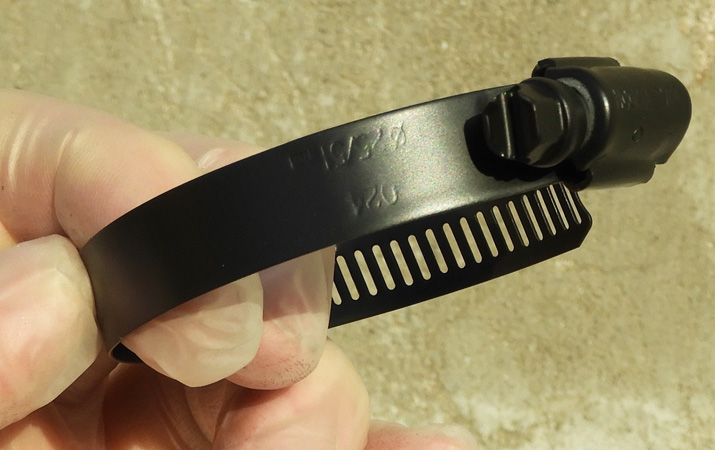

800 Horsepower LSR 2-1 Slash Cut
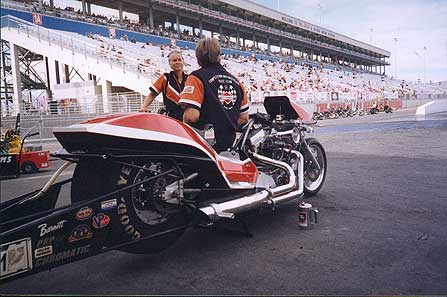
We're not really
sure what a 2-1 has to do with Top Fuel
Nitro motors but when Carl Pelletier asked
us to make a collector for his top fuel
175c.i. PRP motor we whipped up a 4"
diameter collector and sent him the tooling. Take a Tour of
what it takes to run a top fuel bike. Doug
Vancil's hard running Top Fuel Harley
sponsored by Vance and Hines has a 2-1 that
looks like one of their Pro Pipes so when
Carl asked us to build one we made sure the
collector area wouldn't restrict each of the
400hp explosions that were coming from each
cylinder.
Carl qualified 8th out of 32 bikes at the final Las Vegas meet and ran in the sixes at over 200 mph so the 2-1 probably didn't hurt anything. His best speed is 214mph with the 2-1 so it didn't seen to hurt anything. Top Fuel is pure insanity and is addictive as Heroin for those involved. Like they say " Gasoline is for washing parts...Nitro is for Racing!".
What does this have to do with Softails?...Absolutely nothing! We are however in the game 24/7 and you do try to help out where you can.

These days people have all sorts of expectations. They want to be loved. They want to be admired. They don't want their chrome to turn colors. They want "numbers". They want assurances. They want guarantees, warranties, trial periods, and return policies. They don't want the part, they just want everything that goes with their household baggage. It's all part of keeping everything nice and tidy and "best". Fear of rejection. Fear of making any decision.
We just come in and make the best parts we can and that's all there is to it. The rest of the equation is too complicated. There are plenty of people who will assure you till hell freezes over. We don't have time for this.
For those of you who do not understand that 1450 Deg F of exhaust flame front will discolor chrome don't order the parts, or just leave the bike on the trailer..or order the heat shields to cover up the underlying discoloration. Ceramic or chome the pipes get really hot and heat shields provide an air gap to protect and hide things.... Melted tennis shoes, burned pants. Air is the perfect insulator.
It isn't the old days anymore. People with $35,000.00 toys roll up in the screaming fetal position. Joy used to be a basket case that you could get running. Brave new world.
Angst

The agony of decision making can drive a poor consumer insane..."What is the best?"...".."How does it compare?"..."What will I get, what will I gain?"..."When can I get it?"..."Should I get a 2" or a 1 3/4" pipe".."Will the chrome blue?"..."Can I talk to someone who has one?"..."How long have you been in business"...""I've never heard of you"... "How black is the black?"..."Why haven't I seen these before?"..."My bike is at the builder and he has to have the pipe by Friday or I lose my slot!"..."Is the silver as shiny as chrome?"..."I have a wazoo998 cam and billet rocker boxes and a 280 rear tire...will your pipe work?"
Right brain, left brain. Fear of rejection. Fear of being different. Social standing. It's all too much for most people to deal with.
Look at the pictures, take the Red Pill, and start your journey. It's that simple.
If you wish avoid any decision and stay right where you are, just take the Blue Pill. If the journey for truth and power excites your spirit, take the Red Pill.
No Limp Dick Designs
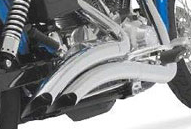
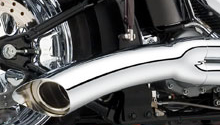
Ever since Jesse James did his original Hell Bent pipes people have either copied them or tried to make whatever they were doing swoopy. If you are a slave to fashion then these might just suit your fancy. At RB Racing we build logical designs that work and leave the limp dick fashion trend to those who love to park and talk.